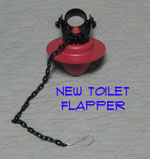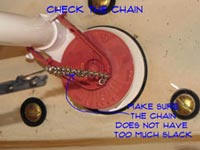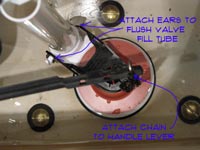 Fixing a toilet flapper leak is usually diagnosed by a trickling sound of water in the tank. However, you may not always hear it. A certain sign is a toilet tank that fills periodically, even when no one is using the toilet.
Fixing a toilet flapper leak is usually diagnosed by a trickling sound of water in the tank. However, you may not always hear it. A certain sign is a toilet tank that fills periodically, even when no one is using the toilet.
You can use dye tablets to check for a slow leak. See the article 'Toilet Tank Leak Detection Tablets' for more information.
There are three possibilities for this problem. First, the flapper may not be adjusted correctly. The Second possibility is the flapper itself. It may be old and worn out. The Third and least desirable problem is the seat on the toilet flush valve may be worn badly and not allow for a tight seal.
Adjusting a Toilet Flapper
 The toilet flapper is controlled by a chain that is connects the toilet handle to the flapper. If the chain is too short, the flapper may not close all of the way, allowing water to leak into the bowl. A chain that is too long, may interfere with the flapper closing completely. Adjusting the chain can solve this problem.
The toilet flapper is controlled by a chain that is connects the toilet handle to the flapper. If the chain is too short, the flapper may not close all of the way, allowing water to leak into the bowl. A chain that is too long, may interfere with the flapper closing completely. Adjusting the chain can solve this problem.
(1) Turn off the water for the toilet at the toilet water supply valve.
(2) Drain the tank by flushing the toilet.
(3) Remove the lid from the toilet tank. It is not fastened and should lift up easily. Be careful where you lay it down. The lid is made of porcelain and will crack and chip easily.
(4) At this point the flapper should be in the down position. Inspect it to see if any portion of the chain is underneath the flapper. Some chains are long and have excess links that have no use. If this is the case, remove the chain from under the flapper and adjust the chain so the excess cannot interfere with the flapper.
(5) Is the chain holding the flapper partially open? Again the chain needs to be adjusted.
(6) You adjust the chain by shortening or lengthening it on the retaining clips that hold it in place. A properly adjusted chain should have a small amount of slack and allow the flapper to close completely. Excess chain should be wrapped around the handle or cut off and discarded.
Replacing a Toilet Flapper

The toilet flapper, as the name implies opens and closes to allow the water from the toilet tank to quickly enter the toilet bowl. The rush of water creates a siphonic action that causes the toilet to flush. When closed the toilet flapper is the only thing keeping the water in the tank.
If the flapper is adjusted properly and it still leaks, the only recourse is to replace it. This is not a big job and generally takes about five minutes. The article 'Replacing a Toilet Flapper' provides complete instructions for this repair.
There are different sizes of toilet flappers. I would be a good idea to take the old one along with you to make sure you get the right size.
(1) Turn off the water for the toilet at the toilet water supply valve.
(2) Drain the tank by flushing the toilet.
(3) Remove the lid from the toilet tank. It is not fastened and should lift up easily. Be careful where you lay it down. The lid is made of porcelain and will crack and chip easily.
(4) Unhook the chain from the toilet flapper. The chain connects the rod from the handle to the toilet flapper. Depressing the handle lifts the flapper, causing the toilet to flush.
(5) The flapper is connected to the toilet flush valve with two rubber ears. You should be able to remove this with just your fingers. Remove the old toilet flapper.
(6) Install the new toilet flapper onto the toilet flush valve. Make sure is moves up and down freely.
(7) Hook the chain to the toilet flapper. You want a little slack on the chain, but not a lot. Test the handle and the flapper when you hook up the chain. Does the flapper open wide when the handle is depressed? A flapper that only opens partially, may close to quickly before all of the water has drained from the tank.
(8) Turn the water back on and make sure the flapper is working properly. This should solve your leaking flapper problem. You can use some 'Toilet Tank Leak Detection Tablets' to make sure.
Replacing a Toilet Flush Valve
The toilet flush valve has the opening that the toilet flapper closes against. Sometimes this opening becomes corroded or deteriorated over time. When this happens the toilet tank will still leak, even with a new flapper installed.
Unfortunately, this is not a simple repair. To replace the toilet flush valve, you need to remove the tank. With the tank removed it is not too difficult to replace the flush valve.
See the article 'Toilet Flush Valve Repair' for instructions on dealing with this issue.
Toilet Flapper Leaking – Summary
Hopefully you have been able to your toilet flapper leaking problem. Most of the time, replacing or adjusting the toilet flapper is an easy task.

